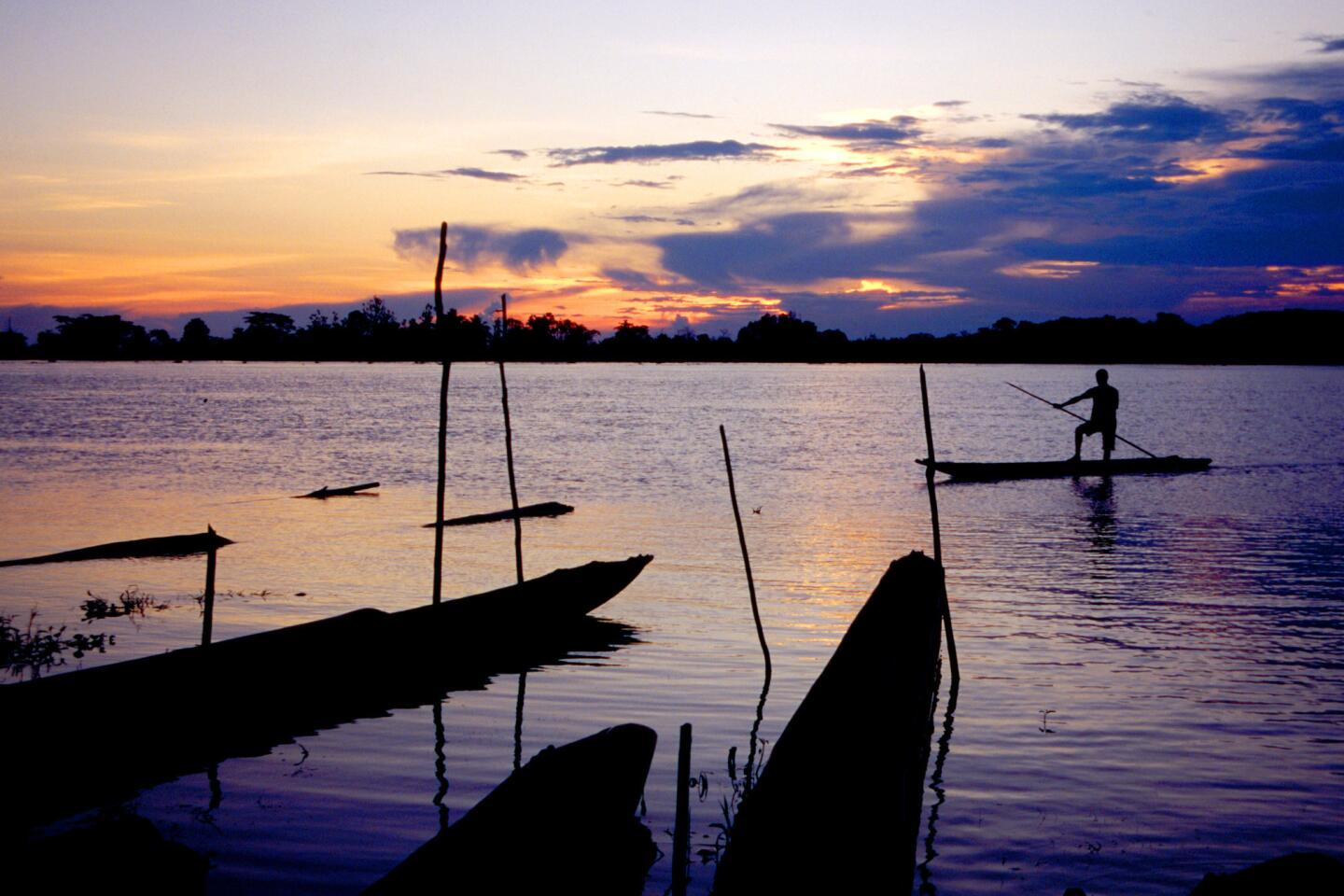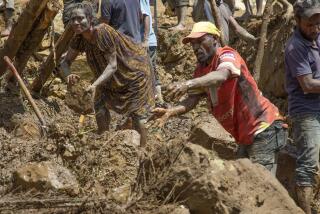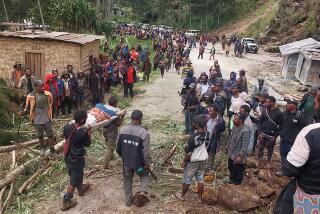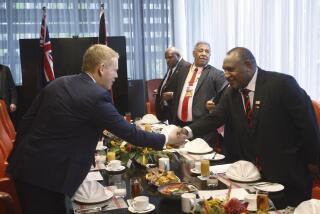Adventures in Papua New Guinea with colorful birds, village wigmen and off-the-grid life
Reporting from PORT MORESBY, Papua New Guinea — My multilingual parents were not shy about imparting pearls of wisdom, the most important always reinforced in English.
This was one: “It’s impolite to stare, so don’t do it. Period.”
Despite my parents’ admonition, my travel partner, George, and I would become veritable gawking experts during 10 days spent here last year. Ample opportunities presented themselves as we explored several villages, met locals, absorbed unusual customs and experienced off-the-grid travel.
Papua New Guinea, or PNG, is in the Southwest Pacific and makes up the eastern half of the second-largest island on Earth.
Its linguistic landscape alone is one of the most diverse in the world: More than 800 indigenous languages are spoken.
Add to that prolific bird life, and flora and fauna found nowhere else in the world, and you have a place like no other.
But it’s a place you have to want to visit because it takes enormous effort just to get here.
To wit: The trip from Los Angeles to Port Moresby, PNG’s dusty capital, takes about 25 hours. And that’s before travel to the more remote regions we visited.
Moresby is less a city and more a transient hub, a jumping-off point for the rest of the country. It took only one afternoon to visit Moresby’s important sites: the ornate A-framed Parliament House; the National Museum and Art Gallery, containing displays of fishing equipment, pottery, and ceremonial masks; and the Port Moresby Nature Park, botanical gardens showcasing PNG’s plants and wildlife, including more than 11,000 orchids and all three species of cassowaries (ostrich-size flightless birds), plus several parrot species.
Then the big adventure began.
From Moresby, a one-hour flight took us to Mt. Hagen in the Western Highlands and after an hour’s drive, our staring began in earnest in Pulga Village.
In Pulga, inhabited by the Wurup clan, it was impossible not to stare. The men wore only loincloths made of dried bark, leaves and kotekas — gourds that covered their genitals — and their bodies were coated in white clay.
Their heads were covered with ominous-looking ceramic masks, each weighing more than 20 pounds.
The topless matriarch had tattoos above her breasts, and other than a shell and Job’s tears seed necklace wrapped several times around her neck, she wore only a skirt of dried leaves under a pareo made of rough, multi-colored twine.
Atop her head was a bilum bag, a handmade string bag made from plant materials in PNG.
After starting a small bonfire, the matriarch began jumping barefoot through it. Teenage boys and men then started a ritual dance around the matriarch and bonfire to ward off evil spirits and nearby warring clans.
The Wurup live much as their ancestors did hundreds of years ago. But I also saw some glimmers of modern life in the Western Highlands.
While I was strolling with our guide at the open-air Hagen Market, looking at pungent possum hair, leafy tobacco and myriad colorful vegetables, a man lunged for my small canvas satchel. I dodged him.
Locals who saw the would-be-thief beat him on the spot. I later learned that security personnel who came to the market also pummeled him.
These extrajudicial events crystallized how PNG’s traditions are juxtaposed with the modest beginnings of modern life, a parallel I pondered often in our 10 days here.
Exploring Papua New Guinea’s past
To understand what Papua New Guinea is, it helps to understand what it was.
In the years before PNG’s independence from Australia in 1975, New Guinea, as it was then called, was steeped in history, lore, mystery and myth.
More than 40 years later it still is.
In the late 1800s, slavery flourished in New Guinea even as it was being abolished elsewhere. Young men were abducted and forced to work in sugar cane plantations in northern Australia and Fiji, taken by trickery and coercion in a practice known as “blackbirding.” That practice stopped just after the turn of the last century.
In 1884, the northern part of New Guinea was controlled by Germany and the southern part was colonized by Britain. In 1905, Britain transferred its territory to newly formed Australia, and it was renamed Papua.
After an Australian military campaign in World War I, German New Guinea was given to Australia under a League of Nations Mandate.
During World War II, the previously undefeated Japanese stormed Asia and the Pacific and took most of New Guinea and the nearby Solomon Islands.
By September 1942, the Japanese were in a bloody retreat along New Guinea’s famous Kokoda Track, where thousands of Australian and American military troops perished in defense.
Despite its war efforts, the island, governed by Australia, didn’t gain full independence until 1975. It has occasionally struggled with instability, including civil warfare and what sometimes seem like insurmountable problems.
More than a third of Papuans live in poverty; life expectancy is 67 years, placing it 169th out of 224 countries ranked in the CIA World Factbook. (Monaco is first at 89.5 years and Chad is last at a little more than 50.) Nearly a third of its citizens cannot read or write.
In several PNG villages, locals spoke to me openly of multiple brides and the prices paid for them, as though both were customary and common around the world. Many Papuans identify as Christians, but those beliefs exist side by side with ideas and customs handed down the generations.
No wonder PNG took hold of my imagination — and held it tight while we were here.
Far off the grid in the villages of Papua New Guinea
In a five-seater 1973 Beechcraft Baron piloted by Aussie Bob Bates, we flew northwest from Hagen in Papua New Guinea’s center, landing on a frighteningly short airstrip 300 feet from the Karawari River, a tributary of the mighty Sepik River.
This lowland rainforest in the East Sepik Province foothills reveals Mother Nature’s majesty, with its wide, winding river, towering palm trees and lush foliage.
But it has been utterly forgotten by Father Time.
It is as far off the grid as I have ever been; there was no infrastructure of any kind.
Through squishy, sticky mud that almost sucked off our shoes, we walked from the plane to the riverside where a pontoon awaited with our guide, Paul, a Karum tribe member from nearby Yimas Village.
Villages along the meandering river appeared seemingly out of nowhere as we headed upriver. The quiet was punctuated by the ruckus of splashing and children playing in the water.
This was the backdrop for what the region didn’t have: running water, electricity, cell service. The subsistence farmers and their families have little outside influence, other than the occasional intrepid traveler.
The pontoon docked about 20 minutes later and Argus, manager of the 12-room Karawari Lodge, drove us 10 minutes uphill on a potholed dirt road.
Our rooms faced the river from high on a hill. While we ate lunch in the open-air dining pavilion, a black hornbill named Johnny — a creature that seemed larger than my 20-pound dog — perched on the veranda’s railing. Johnny sauntered inside and joined us for a few minutes then got bored, perhaps by our conversation, and departed.
Later, we crossed the river with Paul to Kundiman Village, inhabited by the Yokoium tribe. The men, covered in white clay, were chopping sago palm trees for their pulp, which became a flavorless starch similar to poi. The women invited us into their open pavilion where they cooked this dietary staple, along with a river fish stew.
The women were topless and the men were adorned only with leaves, feathers and kotekas. We on the other hand were clad head to toe to try to ward off malaria-carrying nat-nats, or mosquitoes. (Malaria is No. 7 on PNG’s top 10 causes of death, according to the Centers for Disease Control and Prevention.)
In the morning we headed downriver with Paul and briefly visited Manjami, another riverside village, then headed upriver to Konmae Village, surrounded by dense jungle.
As we traversed the river, a teenage girl glided by in a canoe with a cuscus, a honey-colored marsupial found here and in Australia, perched atop her head.
Her back and upper arms were covered with raised scars from rituals that reflect tribal allegiance.
After lunch on the pontoon, we stopped at the Tanganbit Village, home to the Alamblack tribe. Alamblack people were well-known headhunters and cave dwellers, but in 1959 the Australians moved them riverside.
Although indigenous women are not allowed, I was permitted into their haus tambaran, an A-frame meeting and spirit house in which an array of human skulls was lined up on a long mantel.
Many of the skulls, Paul explained, belonged to their tribal ancestors; others may have belonged to those captured during clan wars with neighboring tribes.
It was dim inside, and I was beginning to feel claustrophobic. I stepped outside for some air.
Returning later to the lodge, I had a cold shower and a warm beer. I would have preferred those temperatures reversed, but that warm beer tasted like fine cognac.
The next day, flying southeast, we arrived at the most remote part of Hela Province and its tiny capital, Tari.
Forty minutes up Highlands Highway brought us to Ambua Lodge, which offered views of the Tari Basin and Huli homeland, the largest ethnic group in the region.
Later, we hiked to search for birds of paradise, the colorful birds for which the province is known. After passing a massive waterfall, we hit pay dirt, seeing an azure-colored bird of paradise and a King-of-Saxony with long, curvaceous plumage.
Later that afternoon we set off with our guide to visit nearby villages. At Tigibi Village, Chief Tumbu — husband to three wives, reflecting his elevated tribal status — greeted us warmly.
He was adorned with red, yellow and white facial clay, a large human hair wig, and myriad cassowary quills, pig tusks, shells and septum piercings.
At Lirako Village, along the Hulia River, we met Alice, a guide who told me she was was divorced with two teenagers. She was so desperate to leave her husband — she would not say why — that she said she “saved for years to return the bride price” (in her case several pigs) paid initially from her husband’s family to hers. That way, she said, she could leave him and “he could buy another wife.”
All of the villages we visited in PNG were colorful, interesting and enlightening, but perhaps the most extraordinary was Poroiba Akau, where Huli wigman Chief Kubumu, and wig specialist Nabeta showed us how the decorative human hair wigs are cultivated, grown, cut and adorned.
Here a group of bachelors live together with the chief in jungle isolation for 18 months. Rituals are observed, special diets eaten and spells are cast to advance hair growth.
Once their wig is completed, the men return to their village to marry or they stay another 18 months and grow another wig to sell.
If you go
THE BEST WAY TO PAPUA NEW GUINEA
From LAX, connecting service (change of planes) to Port Moresby is offered on Qantas, Virgin Australia, Philippine, JAL and All Nippon. Round-trip airfares begin at $1,551, including all taxes and fees.
Domestic air travel is best arranged by tour operator or local ground agent.
LOCAL GUIDES
Traveling without a local agent is not advised because of the complexity of domestic travel and safety. I used Audley Travel, (855) 838-8300, www.audleytravel.com, for all arrangements. Nine-day custom tours with Audley start at $6,950. Longer custom Audley tours are available.
For those also interested in snorkeling, including among World War II wrecks, Heritage Expeditions, (866) 285-7884, www.lat.ms/heritage, offers several two-week itineraries in the region aboard its 50-guest ship.
For those wanting a more luxurious sailing experience with top-notch food and service, Silversea, (888) 978-4070, www.silversea.com, is offering several 2018 itineraries in the region.
LEAVE AT HOME
Blue jeans and other dark clothes, which attract nat-nats and other insects, rodents and animals. Also, leave all jewelry, dressy clothes and makeup at home. Utility, not fashion, is key. Take a good flashlight and an extra pair of walking shoes because mud prevails.
Light planes, which serve the outlying areas, have a 22-pound weight maximum for bags, plus a very small carry-on. Luggage can be stored at Moresby hotels until return. Most lodges have low-cost laundry service; two or three changes of clothing will suffice.
TO LEARN MORE
For general information and trip planning on Papua New Guinea: www.papuanewguinea.travel/usa
Embassy of Papua New Guinea, (202) 745-3680, www.pngembassy.org.
More to Read
Sign up for The Wild
We’ll help you find the best places to hike, bike and run, as well as the perfect silent spots for meditation and yoga.
You may occasionally receive promotional content from the Los Angeles Times.







